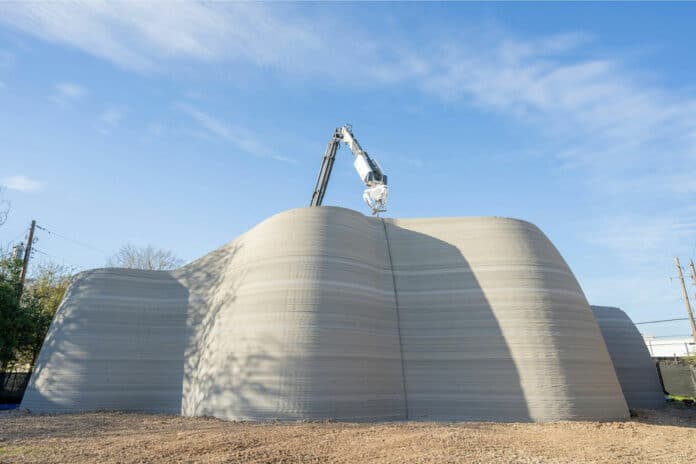ICON has some exciting new products and technologies that aim to revolutionize the construction industry. Their new robotic printer that enables multi-story construction, low-carbon building material, digital catalog for residential architecture with ready-to-build home designs, and AI Architect for home design and construction all sound like innovative solutions.
ICON believes that together, these technologies make its construction technology platform a faster, more sustainable way to build high-quality housing more efficiently and affordably around the world.
Phoenix, ICON’s new multi-story robotic construction system, is a multi-story robotic construction system that can print an entire building enclosure, from foundations to roof structures. This advanced system is designed to increase speed and size while reducing setup time and the number of required operators, which will ultimately reduce ICON’s printing costs by half.
The ICON team wanted to create a 3D printer that is easier to set up and move around, requires fewer operators, and can complete larger tasks faster. The Phoenix printer comprises a large articulated arm that moves freely on a rotating base, unlike the company’s previous Vulcan printer, which is fixed to a pillar and cross-beam structure.
The team faced the challenge of ensuring accuracy in building livable structures with a head attached at the end of a swinging arm. However, they were able to create a stabilization system that prevents the extruding nozzle at the end of the arm from swaying due to its movements or winds from the environment. With this new system, the printer can print larger structures like Phoenix House and even those with multiple stories.
ICON is now accepting orders for projects using Phoenix at an affordable starting price of $25 per square foot for wall systems or $80 per square foot, including foundations and roofs. This is a significant cost reduction compared to conventional wall system construction. In fact, it could potentially save up to $25,000 for the average American home versus conventional construction. The first engineering prototype of Phoenix days before had completed a 27-foot-tall architectural demonstration structure, now on display in Austin, TX.
“In the future, I believe nearly all construction will be done by robots, and nearly all construction-related information will be processed and managed by AI systems,” said Jason Ballard, ICON Co-Founder and CEO. “It is clear to me that this is the way to cut the cost and time of construction in half while making homes that are twice as good and more faithfully express the values and hopes of the people who live in them.”
The company has also recently announced the release of Vitruvius, an AI system for designing and building homes. It aims to take human and project inputs and produce robust architecture, plans, permit-ready designs, budgets, and schedules. Vitruvius will help anyone design a home and generate floor plans, interior renders, and exterior renders of their homes in just a matter of minutes.
By the end of this year, Vitruvius plans to progress all the way through schematic designs and even produce full construction documents, budgets, and schedules in the following year. What sets Vitruvius apart from other design platforms is its unique combination of design and construction knowledge, ensuring that the designs produced are aesthetically pleasing but also practical, and feasible.
The latest announcements from ICON sound promising as they aim to empower the construction industry with 3D-printing technology to build more attractive and sustainable neighborhoods and communities.
